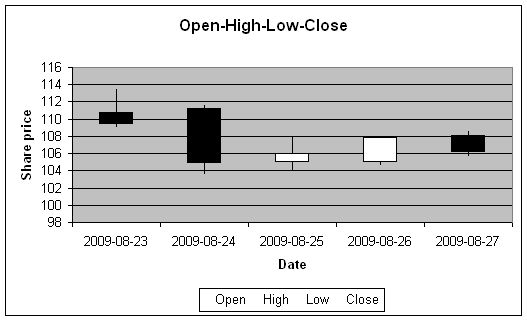NAME
Stock - A writer class for Excel Stock charts.
SYNOPSIS
To create a simple Excel file with a Stock chart using Spreadsheet::WriteExcel:
#!/usr/bin/perl -w
use strict;
use Spreadsheet::WriteExcel;
my $workbook = Spreadsheet::WriteExcel->new( 'chart.xls' );
my $worksheet = $workbook->add_worksheet();
my $chart = $workbook->add_chart( type => 'stock' );
# Add a series for each Open-High-Low-Close.
$chart->add_series( categories => '=Sheet1!$A$2:$A$6', values => '=Sheet1!$B$2:$B$6' );
$chart->add_series( categories => '=Sheet1!$A$2:$A$6', values => '=Sheet1!$C$2:$C$6' );
$chart->add_series( categories => '=Sheet1!$A$2:$A$6', values => '=Sheet1!$D$2:$D$6' );
$chart->add_series( categories => '=Sheet1!$A$2:$A$6', values => '=Sheet1!$E$2:$E$6' );
# Add the worksheet data the chart refers to.
# ... See the full example below.
__END__DESCRIPTION
This module implements Stock charts for Spreadsheet::WriteExcel. The chart object is created via the Workbook add_chart() method:
my $chart = $workbook->add_chart( type => 'stock' );Once the object is created it can be configured via the following methods that are common to all chart classes:
$chart->add_series();
$chart->set_x_axis();
$chart->set_y_axis();
$chart->set_title();These methods are explained in detail in Spreadsheet::WriteExcel::Chart. Class specific methods or settings, if any, are explained below.
Stock Chart Methods
There aren't currently any stock chart specific methods. See the TODO section of Spreadsheet::WriteExcel::Chart.
The default Stock chart is an Open-High-Low-Close chart. A series must be added for each of these data sources.
The default Stock chart is in black and white. User defined colours will be added at a later stage.
EXAMPLE
Here is a complete example that demonstrates most of the available features when creating a Stock chart.
#!/usr/bin/perl -w
use strict;
use Spreadsheet::WriteExcel;
my $workbook = Spreadsheet::WriteExcel->new( 'chart_stock_ex.xls' );
my $worksheet = $workbook->add_worksheet();
my $bold = $workbook->add_format( bold => 1 );
my $date_format = $workbook->add_format( num_format => 'dd/mm/yyyy' );
# Add the worksheet data that the charts will refer to.
my $headings = [ 'Date', 'Open', 'High', 'Low', 'Close' ];
my @data = (
[ '2009-08-23', 110.75, 113.48, 109.05, 109.40 ],
[ '2009-08-24', 111.24, 111.60, 103.57, 104.87 ],
[ '2009-08-25', 104.96, 108.00, 103.88, 106.00 ],
[ '2009-08-26', 104.95, 107.95, 104.66, 107.91 ],
[ '2009-08-27', 108.10, 108.62, 105.69, 106.15 ],
);
$worksheet->write( 'A1', $headings, $bold );
my $row = 1;
for my $data ( @data ) {
$worksheet->write( $row, 0, $data->[0], $date_format );
$worksheet->write( $row, 1, $data->[1] );
$worksheet->write( $row, 2, $data->[2] );
$worksheet->write( $row, 3, $data->[3] );
$worksheet->write( $row, 4, $data->[4] );
$row++;
}
# Create a new chart object. In this case an embedded chart.
my $chart = $workbook->add_chart( type => 'stock', embedded => 1 );
# Add a series for each of the Open-High-Low-Close columns.
$chart->add_series(
categories => '=Sheet1!$A$2:$A$6',
values => '=Sheet1!$B$2:$B$6',
name => 'Open',
);
$chart->add_series(
categories => '=Sheet1!$A$2:$A$6',
values => '=Sheet1!$C$2:$C$6',
name => 'High',
);
$chart->add_series(
categories => '=Sheet1!$A$2:$A$6',
values => '=Sheet1!$D$2:$D$6',
name => 'Low',
);
$chart->add_series(
categories => '=Sheet1!$A$2:$A$6',
values => '=Sheet1!$E$2:$E$6',
name => 'Close',
);
# Add a chart title and some axis labels.
$chart->set_title( name => 'Open-High-Low-Close', );
$chart->set_x_axis( name => 'Date', );
$chart->set_y_axis( name => 'Share price', );
# Insert the chart into the worksheet (with an offset).
$worksheet->insert_chart( 'F2', $chart, 25, 10 );
__END__This will produce a chart that looks like this:

AUTHOR
John McNamara jmcnamara@cpan.org
COPYRIGHT
Copyright MM-MMX, John McNamara.
All Rights Reserved. This module is free software. It may be used, redistributed and/or modified under the same terms as Perl itself.